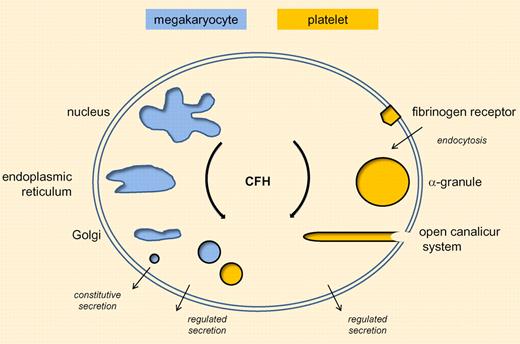CFH protects platelets against complement attack. In this issue of Blood, Licht and colleagues unexpectedly identify CFH at intracellular localizations other than alpha granules, where CFH had previously been thought to localize. They show accumulation of exogenous CFH in the platelet cytoplasm, as well as production of endogenous CFH by megakaryocytes.
Complement factor H (CFH) is a member of the regulator of complement activation gene cluster and an essential component of the alternative pathway, directing it toward pathogens and protecting host tissue. CFH is produced by the liver. Extrahepatic synthesis occurs in peripheral blood lymphocytes, endothelial cells, and fibroblasts. These cells supply the CFH that accumulates at sites of infection and inflammation and protect the endothelium. Defects in CFH caused by mutations or autoantibodies result in cellular damage. Destruction of glomerular endothelial cells exposes subendothelial matrix, inducing platelet adhesion, microthrombi, and the atypical hemolytic uremic syndrome (HUS).1
Pathways for CFH accumulation and secretion in megakaryocytes and platelets.
Pathways for CFH accumulation and secretion in megakaryocytes and platelets.
Platelets have been known previously to contain CFH and secrete it upon activation, a process long interpreted as secretion of α-granule contents.2 These secretory granules store 3 types of proteins: First, proteins synthesized by the platelet progenitors, the megakaryocyte. An example is von Willebrand factor, which assistsin platelet adhesion to the damaged vessel wall. Second, proteins taken up from the surrounding plasma by receptor-mediated endocytosis and stored in concentrations higher than in plasma. An example is fibrinogen taken up through binding to the fibrinogen receptor. Third, proteins taken up through fluid-phase endocytosis and stored in concentrations lower than in plasma. Examples are albumin and immunoglobulins. Granule contents are released through the open canalicular system (see figure).
As in any nucleated cell, the megakaryocyte transcribes message from genes in the nucleus, translates it into proteins in the cytosol, and transports signal peptide–containing proteins to the endoplasmic reticulum and Golgi. Here, they are packaged in granules that fuse either directly with the plasma membrane (constitutive secretion) or upon later activation (regulated secretion). Proteins lacking a signal peptide stay behind in the cytosol.3
The exciting findings of Licht et al4 do not appear in line with the conventional secretory pathway. First, there is the extensive accumulation of CFH in the cytosol of platelets in healthy persons visualized by a beautiful laser fluorescence confocal microscopic approach. Second, platelets from a patient with ARC (arthrogryposis, renal tubular dysfunction, cholestasis) lack α-granules but contain a normal amount of CFH, as do normal megakaryocytes. Third, platelets from an HUS patient with complete CFH deficiency accumulate CFH on transfusion with normal plasma. Fourth, normal platelets take up extracellular CFH but do not store it in granules.
CFH is encoded by a single gene (HF1) and it contains a signal peptide(MRLLAKIICLMLWAICVA, UniProt-KB/Swiss-Prot P08603, CFAH_HUMAN). Thus, CFH is a protein released through the secretory pathway, probably including α-granules. These granules might well accumulate extracellular CFH, but whether this involves receptor-mediated or fluid-phase endocytosis depends on concentrations of granular and extracellular CFH. Thus, a next step to understand these intriguing findings should focus on the presence of membranes that surround secretable proteins and proteins taken up from the medium (not detectable with the present approaches), the quantitative aspects of CFH accumulation (difficult but essential to identify uptake phenomena), conformation of CFH presence in other patients lacking α-granules (eg, Gray platelet syndrome), and identification of the receptor for CFH-mediated endocytosis (if present). Should all attempts fail to explain CFH localization and transport in models of conventional secretory and uptake pathways, CFH will be one of the first proteins in megakaryocytes subject to regulated, unconventional protein secretion.5 This is again a starting point for new and exciting research.
Conflict-of-interest disclosure: The author declares no competing financial interests. ■


This feature is available to Subscribers Only
Sign In or Create an Account Close Modal